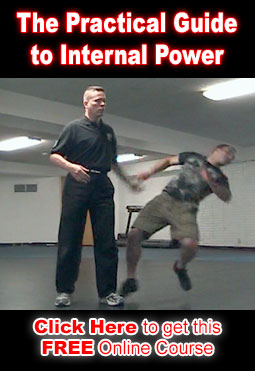I’ve been asked a couple times recently about what exactly the term “Indoor Training” means.
Basically “indoor” is a term for information in a system that is only taught to a privileged few.
In other words it’s stuff that is only taught ‘behind closed doors’ instead of in public.
There are different names for this practice.
Sometimes you have to be a family member or become a disciple to get this info. Some systems are only passed on to one person.
Everyone else is kept in the dark.
No matter how dedicated or how long they study.
Now, this practice makes sense if you go back before modern firearms and you have to worry about war with a nearby city, family or tribe.
But in the modern world this doesn’t protect you from unpleasant folks. They’ll just stock up on firearms, try to run you over with a car or send their lawyers after you.
A lot of things have been lost because of this practice.
And it’s the primary reason there is so much poor quality kung fu and Internal martial arts out there.
There are two reasons this practice continues…
IGNORANCE & FEAR
Ignorance comes in a few different forms.
Some people never learn they’ve been held out on. They simply teach what they learned without ever realizing they’re doing themselves, their students and their art a disservice.
Others perpetuate this practice because it’s what they were taught . They were handed this tradition and they never questioned it or considered the damage they’re doing to their students and the art they’re trying to preserve.
And then there’s FEAR…
Fear that the competition will steal their ‘secrets.’
Fear that their students will learn everything they know and then leave. (and maybe become the competition.)
These fears, and those like them, are a fear of losing power and control over others.
(If your goal is power over others I suggest you dream big and go into politics or start a career in our financial industry.)
These fears are destructive.
If a teacher only teaches the good stuff to a few people then a lot of their time is spent teaching not so good stuff.
Their skill level will suffer because of all this time spent working with poor quality training. (which leads to an increase in fear.)
If they only have one or two disciples then they have a huge problem if one goes rogue or is killed in a car wreck.
And all those students who studied for years without developing the skill they should have…
..their skill level will form the basis of the arts reputation in the years to come.
If you are constantly learning and you teach everybody openly…
– then a rogue student will quickly be surpassed by his peers and the loss of a senior student won’t be the end of the system.
– You will never run out of things to teach.
– and with more skilled students your skill will grow faster as well.
There is also an almost legitimate fear that someone they teach will use their knowledge to hurt someone.
Thing is, indoor training is NOT any easier.
It still takes HARDWORK over TIME.
(It’s just much much more effective.)
In today’s world the bad eggs have access to much easier ways to hurt somebody…
And the good eggs…
…The hardworking students who will carry these arts forward…
The don’t need any extra obstacles in their path.
These arts are hard enough already.
The solution is simple.
LEARN and TEACH..
LEARN the best stuff you can find anywhere you can find it.
Become a shining example of what is possible with these arts.
and TEACH.
Share what you know.
Make sure your students become high quality examples to carry these arts forward.
It’s Simple…
learn, teach and never ever stop.
Sigung Clear was lucky. In the early years of his training he got access to the indoor teaching of some highly skilled teachers.
But instead of trying to coast on that tiny bit of luck, like many folks do,
He added a whole bunch of Hard Work.
Constantly training and seeking out the best teachers and learning the best stuff he could.
Over and over. Again and again.
…for over 30 years now.
To this day he still makes sure to get around 6 weeks of full time (40 hours or more) instruction per year.
(That’s about 240 hrs per year. To put it in perspective if you attend a 2hr class twice a week that’s 208 hrs per year if you never ever miss class.)
That’s why our programs are able to deliver the results that they do.
…because we skip all the BS and start with the good stuff right away.
Our hope is that if we keep doing this often enough and loudly enough more folks will follow our example.
If you’d like try the good stuff approach then go check this out:
